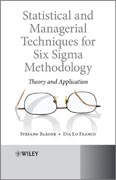
Statistical and managerial techniques for Six Sigma methodology: theory and application
Barone, Stefano
Franco, Eva Lo
Statistical and Managerial Techniques for Six Sigma Methodology examines the methodology through illustrating the most widespread tool and techniques involved in Six Sigma application. Both managerial and statistical aspects of Six Sigma will be analyzed, allowing the reader to apply these tools in the field. This book offers an insight on variation and risk management, and focuses on the structure and organizational aspects of the Six Sigma projects. It covers six sigma methodology, basic managerial techniques, basic statistical techniques, methods for variation and risk management and advanced statistical techniques. Clear and practical examples and demonstrations are included throughout the book. Packed with clear examples and case studies to illustrate the conceptsand methodologies used in Six Sigma. Looks at both managerial and statisticalaspects of Six Sigma, covering both basic and more advanced statistical techniques. Provides a chapter featuring case studies, equipping readers with the tools and techniques to apply methodology to real situations. Suitable for adoption in all courses for Six Sigma Green Belt and Black Belt Features a supporting website containing datasets Well suited for Master level students in engineering and quality management, as well as MBA. Quality Managers, Consultants, and public and private companies implementing Six Sigma will also benefit greatly from the book. INDICE : 1 Six Sigma Methodology 1.1 Management by Process 1.1.1 The Concept of Process 1.1.2 Managing by Process 1.1.3 The Process Performance Triangle1.1.4 Customer Satisfaction 1.1.5 The Success of Enterprise 1.1.6 Innovation and Six Sigma 1.2 Meanings and Origins of Six Sigma 1.2.1 Variation in Products and Processes 1.2.2 Meaning of Six Sigma 1.2.3 Six Sigma Process 1.2.4 Origins of Six Sigma 1.2.5 Six Sigma: Some Definitions 13 Six Sigma Projects 1.3.1 Why Implement Six Sigma Projects? 1.3.2 Six Sigma Paths 1.4 The DMARIC Path 1.4.1 Human Resources and Training References 2 Basic Managerial Techniques 2.1 For Brainstorming 2.1.1 CauseEffect Diagram 2.1.2 Affinity Diagram (KJ Analysis) 2.2 To Manage the Project 2.2.1 Work Breakdown Structure 2.2.2 Gantt Chart 2.3 To Describe and Understand the Processes 2.3.1 The SIPOC Scheme 2.3.2 The Flow Chart 2.3.3 The ServQual Model 2.4 To Direct the Improvement 2.4.1 The Kano Model References 3 Basic Statistical Techniques 3.1 To Explore Data 3.1.1 Fundamental Concepts and Phases of the Exploratory Data Analysis 3.1.2 Empirical Frequency Distribution of a Numerical Variable 3.1.3 Analysis by Stratification 3.1.4 Other Graphical Representations 3.2 To Define and Calculate the Uncertainty 3.2.1 Definitions of Probability 3.2.2 Events and Probabilities in theVenn Diagram 3.2.3 Probability Calculation Rules 3.2.4 Dispositions, Permutations and Combinations 3.3 To Model the Random Variability 3.3.1 Definition of Random Variable 3.3.2 Probability Distribution Function 3.3.3 Probability MassFunction for Discrete Random Variables 3.3.4 Probability Density Function forContinuous Variables 3.3.5 Mean and Variance of a Random Variable 3.3.6 Principal Models of Random Variables 3.4 To Draw Conclusions from Observed Data 3.4.1 The Inferential Process 3.4.2 Sampling and Samples 3.4.3 Adopting a Probability Distribution Model by Graphical Analysis of the Sample (Probability Plot)3.4.4 Point Estimation of the Parameters of a Gaussian Population 3.4.5 Interval Estimation 3.4.6 Hypothesis Testing References 4 Advanced Managerial Techniques 4.1 To Describe Processes 4.1.1 IDEF 0 4.2 To Manage a Project 4.2.1 Project Evaluation and Review Technique 4.2.2 Critical Path Method 4.3 To AnalyseFaults 4.3.1 Failure Mode and Effect Analysis 4.3.2 Fault Tree Analysis 4.4 To Make Decisions 4.4.1 Analytic Hierarchy Process 4.4.2 Response Latency Model4.4.3 Quality Function Deployment References 5 Advanced Statistical Techniques to Study the Relationships between Variables 5.1 To Study the Relationships between Variables 5.1.1Linear Regression Analysis 5.1.2Logistic Regression Models 5.1.3Introduction to Multivariate Statistics 5.2 To Monitor and Keep Processes under Control 5.2.1Process Capability 5.2.2Online Process Control and Main Control Charts 5.2.3Offline Process Control 5.3 To Improve Products, Services and Production Processes 5.3.1Robustness Thinking 5.3.2Variation Mode and Effect Analysis 5.3.3Systemic
- ISBN: 978-0-470-71183-5
- Editorial: John Wiley & Sons
- Encuadernacion: Cartoné
- Páginas: 400
- Fecha Publicación: 16/03/2012
- Nº Volúmenes: 1
- Idioma: Inglés
